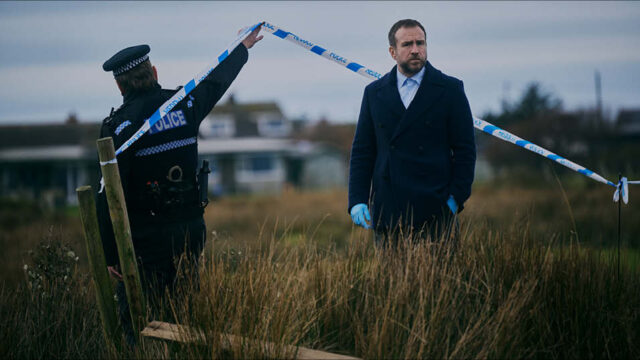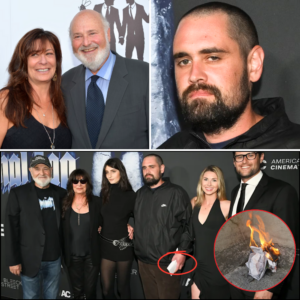In the shadowy realms of television crime dramas, where small-town secrets fester like wounds under the skin, few series arrive with the tidal force of “Under Salt Marsh.” This six-part Sky Original thriller, which crashed onto screens in early September 2025, has already reshaped the genre’s landscape, drawing inevitable comparisons to HBO’s “Mare of Easttown.” But where Kate Winslet’s Mare Sheehan grappled with personal demons in a rust-belt Pennsylvania enclave, Kelly Reilly’s Jackie Ellis in “Under Salt Marsh” confronts a tempest—both literal and metaphorical—that threatens to swallow an entire Welsh coastal community whole. Critics are buzzing: is this the superior successor? With Reilly trading her Yellowstone ranch for rain-lashed shores, the answer seems a resounding yes. “Under Salt Marsh” isn’t just a whodunit; it’s a seismic unraveling of grief, guilt, and the inexorable pull of the past, all set against a backdrop of encroaching seas that mirror the characters’ drowning souls.
Premiering on Sky Atlantic and NOW in the UK and Ireland on September 8, 2025, the series has swiftly climbed streaming charts, amassing over 2.5 million viewers in its first week—a testament to Reilly’s star power and the word-of-mouth frenzy sparked by early screenings. Created, written, and directed by Claire Oakley (whose 2020 indie “Make Up” earned cult status for its psychological unease), “Under Salt Marsh” marks a bold leap for Sky Studios into prestige television. Produced by Little Door Productions in association with Sky, the show was filmed entirely on location in Wales, from the rugged cliffs of Pembrokeshire to the misty salt marshes of the Gower Peninsula. This authenticity bleeds into every frame, turning the fictional town of Morfa Halen into a character as vital—and volatile—as the humans who inhabit it. Nestled between jagged mountains and a relentless, rising sea, Morfa Halen is a place where the land fights back, much like the secrets buried beneath its peaty soil.

The plot ignites with a discovery that chills to the bone: Jackie Ellis, a former detective now teaching at the local primary school to escape her shattered life, stumbles upon the body of her eight-year-old pupil, Cefin, washed up on the marsh’s edge. At first glance, it’s a tragic drowning—perhaps a riptide or a careless wander into the treacherous tides. But Jackie, haunted by the unsolved disappearance of her own niece, Nessa, three years prior, senses the hand of foul play. That earlier case didn’t just evade capture; it imploded Jackie’s world. Accused of botching the investigation through personal bias, she lost her badge, her marriage crumbled under the weight of blame, and her family fractured into silence. Now, with Cefin’s death echoing Nessa’s vanishing like a cruel refrain, Jackie is yanked back into the fray. Enter Detective Eric Bull (Rafe Spall), her ex-partner and the man whose differing conclusions on the old case drove a wedge between them deeper than the Irish Sea. As a once-in-a-generation storm brews offshore, barreling toward Morfa Halen with winds that howl like vengeful spirits, Jackie and Bull must bury the hatchet—or risk the evidence, and the town itself, being erased by the deluge.
What follows is a masterclass in escalating tension, where every rain-sodden clue peels back layers of communal complicity. The series doesn’t rush its revelations; instead, it simmers, allowing the storm’s approach to parallel the investigation’s urgency. Interviews with locals unearth whispers of illicit affairs, petty vendettas, and long-suppressed traumas tied to the town’s economic desperation—failing fisheries, eroding coastlines, and the ghost of industrial decline. Is Cefin’s death linked to Nessa’s through a predatory figure lurking in the shadows? Or does it expose a darker conspiracy, one that implicates pillars of the community? Oakley, drawing from her roots in atmospheric horror, infuses the narrative with subtle supernatural undertones—not ghosts, per se, but the eerie sense that the marsh itself harbors grudges, swallowing secrets and spitting out half-truths. The cold case’s return isn’t mere plot device; it’s a Pandora’s box that threatens to dismantle families, friendships, and the fragile illusion of safety in a place where the sea claims what it wants.
Kelly Reilly, fresh off seven seasons as the steely Beth Dutton in “Yellowstone,” delivers a performance that cements her as one of television’s most versatile forces. Here, stripped of cowboy grit and venomous one-liners, Reilly embodies Jackie’s wild, untamed essence—a woman as much part of the landscape as the gales that whip her hair. Her eyes, sharp as flint, betray flickers of vulnerability beneath the resolve; in quieter moments, teaching poetry to wide-eyed kids or staring out at the churning waves, she conveys a profound isolation that rivals Winslet’s Mare in raw emotional heft. Reilly has spoken in interviews about the role’s pull: “Jackie isn’t broken; she’s remade by her scars. Playing her felt like wrestling the sea—fierce, unpredictable, and utterly alive.” It’s a portrayal that explodes the notion of Reilly as a genre staple, earning her early buzz for awards contention and positioning “Under Salt Marsh” as a showcase for her dramatic range.
Rafe Spall, as the rumpled yet dogged Eric Bull, provides the perfect counterpoint—a man whose affable exterior masks a cauldron of regret. Best known for “The English” and “Trying,” Spall brings a lived-in authenticity to Bull, whose return to Morfa Halen stirs old resentments. Their chemistry crackles with unspoken history; scenes of reconciliation unfold like duels, words slicing deeper than any blade. The supporting ensemble elevates the stakes further. Jonathan Pryce, the Welsh icon from “The Crown” and “Slow Horses,” commands as Solomon Bevan, Morfa Halen’s enigmatic mayor with ties to the town’s underbelly—his gravitas lends weight to the community’s unraveling. Naomi Yang shines as Jess Deng, a sharp-tongued outsider journalist whose probing unearths uncomfortable truths, while Harry Lawtey (“Industry”) plays Dylan Rees, Cefin’s grieving father whose rage masks a pivotal secret.
Rounding out the cast are standouts like Dinita Gohil as Jackie’s estranged sister, whose brittle warmth underscores familial fallout; Brian Gleeson (“Bad Sisters”) as a suspicious fisherman with a grudge; and Kimberley Nixon as a school colleague harboring her own ghosts. Mark Stanley (“Happy Valley”) adds brooding intensity as a local cop resentful of Bull’s return, while Dino Fetscher, Lizzie Annis, Rhodri Meilir, and Julian Lewis Jones flesh out the ensemble with nuanced portrayals of everyday folk caught in extraordinary horror. This star-studded lineup, predominantly Welsh and Irish talent, ensures cultural verisimilitude, with dialogue laced in subtle accents and idioms that ground the drama in place.
Thematically, “Under Salt Marsh” transcends the crime thriller template, weaving environmental peril with psychological excavation. Morfa Halen isn’t just a setting; it’s a metaphor for climate anxiety—the encroaching sea symbolizing how past sins flood the present, much like rising waters threaten coastal erasure. Oakley, an executive producer alongside Reilly, Elwen Rowlands, and Megan Spanjian, infuses the script with heartache and resilience, exploring how grief binds a community even as it frays it. Episodes penned by Jonathan Harbottle and Nikita Lalwani add fresh perspectives, delving into themes of gender, class, and the immigrant experience through Yang’s Jess. Directed with Mary Nighy handling key installments, the visuals—lensed by cinematographer Suzie Lavelle—are a symphony of grays and greens: mist-shrouded marshes at dawn, waves crashing like accusations, and interiors lit by flickering storm light that casts long, accusatory shadows.
Production details underscore the series’ commitment to immersion. Filming wrapped in late February 2025 after a grueling shoot amid actual Welsh weather, with Scott Bassett and Emma Duffy as producers. Supported by Creative Wales, the project boosted local crew employment and trainee programs, infusing authenticity into every rain-drenched take. The score, a haunting blend of cello dirges and wind-swept folk motifs by composer Isobel Waller-Bridge, amplifies the dread without overpowering the dialogue. No CGI tempests here—practical effects and on-location storms deliver visceral peril, making viewers feel the salt spray and the ground shift beneath their feet.
Critics have crowned “Under Salt Marsh” a triumph, with early reviews pouring in post-premiere. The Guardian’s Lucy Mangan hailed it as “a slow-burn masterpiece that outshines ‘Mare of Easttown’ in atmospheric depth and emotional ferocity,” praising Reilly’s “tour de force” that “makes vulnerability a weapon.” Variety called it “a gripping descent into communal darkness, where the sea is as merciless a detective as Jackie herself.” The Independent noted its “spine-tingling fusion of noir and eco-horror,” while Empire magazine deemed it “the best British thriller since ‘The Capture,’ with twists that hit like rogue waves.” On Rotten Tomatoes, it boasts a 94% fresh rating from 52 reviews, with audiences echoing the sentiment—viewers on social media rave about the bingeable pacing and Pryce’s chilling turn. Some quibble at the deliberate tempo, but most agree: this is prestige TV at its peak, a series that lingers like marsh mist.
Audience reception has been electric, with #UnderSaltMarsh trending across platforms. Fans of “Yellowstone” are stunned by Reilly’s pivot, flooding forums with posts like, “Beth Dutton who? Kelly Reilly just redefined fierce.” Theories abound— is Solomon the key to the cold case? What does the storm unearth beyond evidence?—fueling watercooler debates. International distribution via NBCUniversal ensures a global splash, with U.S. premiere on Peacock slated for late 2025.
In an age of glossy procedurals, “Under Salt Marsh” stands as a raw, rain-soaked rebuke—a reminder that true thrillers thrive in the mud and the murk. Kelly Reilly doesn’t just explode onto screens; she commands them, dragging us into Morfa Halen’s depths where secrets fester and storms rage. Better than “Mare of Easttown”? In its intimate fury and tidal pull, absolutely. As the finale’s waves recede, leaving flotsam of revelation in their wake, one truth emerges: some towns—and some souls—are built to endure the flood. Tune in before the tide turns.




